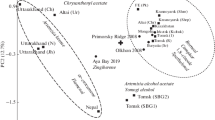Abstract
The aim of this study was to evaluate the variation of essential oils composition of Bidens tripartita L. collected during three successive years (2009–2011). Essential oils were obtained by supercritical CO2 extraction, applying gas chromatographic–mass spectrometric (GC–MS) analysis for identification of volatile compounds afterwards. The essential oils of B. tripartita showed a characteristic chemical composition from year to year, observing both quantitative and qualitative compounds differences. The yield of essential oils was 22 and 35 % higher in 2010 year material than in 2009 and 2011 year, respectively. The main compounds found in the B. tripartita essential oils were α-pinene (3.7–12.1 %), p-cymene (2.8–8.0 %), β-ocimene (40.5–45.9 %), β-elemene (9.9–15.6 %), iso and α-caryophyllenes (4.3–6.8 % and 5.2–8.2 %), and α-bergamotene (3.3–9.4 %). To determine the significance of changes in the identified compounds in the samples, representing different plant collection year, statistical hypothesis testing was applied. For classification of these samples to the groups and evaluation of similarity between them principal component analysis, multivariate analysis of variance and hierarchical cluster analysis techniques were used. The correlation analysis helped to find out the strength of linear relationship between amount of each compound and meteorological data (temperature and precipitations).



Similar content being viewed by others
Abbreviations
- HTC:
-
Hydrothermal coefficient
- HCA:
-
Hierarchical cluster analysis
- LRI:
-
Linear retention indices
- MANOVA:
-
Multivariate analysis of variance
- PCA:
-
Principal component analysis
- RT:
-
Retention time
References
Adams RP (2007) Identification of essential oil components by gas chromatography/quadrupole mass spectroscopy 4th edn. Allured Publishing Corporation, Illinois
Ambuhl R, Ankli A, Richerdt N, Reich E (2011) Pattern Recognition in HPTLC-Fingerprints of Medicinal Plants. International Symposium for High-Performance Thin-Layer Chromatography HPTLC 2011, Basel 6th–8th July 2011. http://www.hptlc.com/pdf/2011basel/P7c.pdf. Accessed 29 February 2012
Aprotosoaie AC, Spac A, Hancianu M, Miron A, Tanasescu VF, Dorneanu V, Stanescu U (2010) The chemical profile of essential oils obtained from fennel fruits (Foeniculum vulgare Mill.). Farmacia 58:46–53
Duke JA, Bogenschutz-Godwin MJ, DuCellier J, Duke P-AK (2002) CRC handbook of medicinal herbs, 2nd edn. CRC MedHerbs, Boca Raton
El-Sayed AM (2010) The pherobase: database of insect pheromones and semiochemicals. http://www.pherobase.com. Accessed 29 February 2012
González-Montelongo R, Lobo MG, González M (2010) Antioxidant activity in banana peel extracts: testing extraction conditions and related bioactive compounds. Food Chem 119:1030–1039
Kaškonienė V, Kaškonas P, Maruška A, Ragažinskienė O (2011) Chemical composition and chemometric analysis of variation in essential oils of Bidens tripartita L. during vegetation stages. Acta Physiol Plant 33:2377–2385
Khajeh M, Yamini Y, Sefidkon F, Bahramifar N (2004) Comparison of essential oil composition of Carum copticum obtained by supercritical carbon dioxide extraction and hydrodistillation methods. Food Chem 86:587–591
Li QQ, Wang G, Huang F, Banda M, Reed E (2010) Antineoplastic effect of β-elemene on prostate cancer cells and other types of solid tumour cells. J Pharm Pharmacol 62:1018–1027
Msaada K, Taarit MB, Hosni K, Hammami M, Marzouk B (2009) Regional and maturational effects on essential oils yields and composition of coriander (Coriandrum sativum L.) fruits. Sci Hortic 122:116–124
Pozharitskaya ON, Shikov AN, Makarova MN, Kosman VM, Faustova NM, Tesakova SV, Makarov VG, Galambosi B (2010) Anti-inflammatory activity of a HPLC-fingerprinted aqueous infusion of aerial part of Bidens tripartita L. Phytomedicine 17:463–468
Qu W, Pan Z, Ma H (2010) Extraction modelling and activities of antioxidants from pomegranate marc. J Food Eng 99:16–23
Reverchon E, De Marco I (2006) Supercritical fluid extraction and fractionation of natural matter. J Supercrit Fluids 38:146–166
Rota MC, Herrera A, Martinez RM, Sotomayor JA, Jordan MJ (2008) Antimicrobial activity and chemical composition of Thymus vulgaris, Thymus zygis and Thymus hyemalis essential oils. Food Control 19:681–687
Selianinov GT (1928) On agricultural climate valuation (in Russian). Proc Agric Meteor 20:165–177
Sezik E, Yesilada E, Shadidoyatov H, Kulivey Z, Nigmatullaev AM, Aripov HN, Takaishi Y, Takeda Y, Honda G (2004) Folk medicine in Uzbekistan: I. Toshkent, Djizzax, and Samarqand provinces. J Ethnopharmacol 92:197–207
Tomczykowa M, Gudej J, Majda T, Gora J (2005) Essential oils of Bidens tripartita L. J Essent Oil Res 17:632–635
Tomczykowa M, Tomczyk M, Jakoniuk P, Tryniszewska E (2008) Antimicrobial and antifungal activities of the extracts and essential oils of Bidens tripartita. Folia Histochem Cytobiol 46:389–393
Tomczykowa M, Leszczynska K, Tomczyk M, Tryniszewska E, Kalemba D (2011) Composition of the essential oil of Bidens tripartita L. roots and its antibacterial and antifungal activities. J Med Food 14:428–433
Wang L-M, Li M-T, Jin W–W, Li S, Zhang S-Q, Yu L-J (2009) Variations in the components of Osmanthus fragrans Lour. essential oil at different stages of flowering. Food Chem 114:233–236
Wolniak M, Tomczykowa M, Tomczyk M, Gudej J, Wawer I (2007) Antioxidant activity of extracts and flavonoids from Bidens tripartita. Acta Poloniae Pharm Drug Res 63:441–447
Acknowledgments
This study was supported by postdoctoral research fellowship, which is being funded by European Union Structural Funds project “Postdoctoral Fellowship Implementation in Lithuania”.
Author information
Authors and Affiliations
Corresponding author
Additional information
Communicated by M. Stobiecki.
Rights and permissions
About this article
Cite this article
Kaškonienė, V., Kaškonas, P., Maruška, A. et al. Essential oils of Bidens tripartita L. collected during period of 3 years composition variation analysis. Acta Physiol Plant 35, 1171–1178 (2013). https://doi.org/10.1007/s11738-012-1156-y
Received:
Revised:
Accepted:
Published:
Issue Date:
DOI: https://doi.org/10.1007/s11738-012-1156-y




